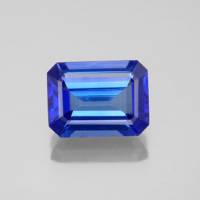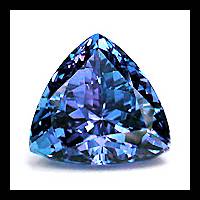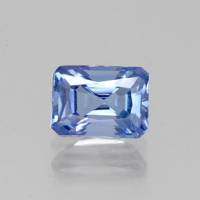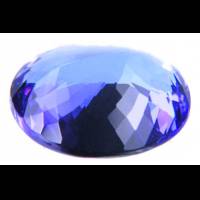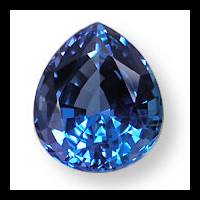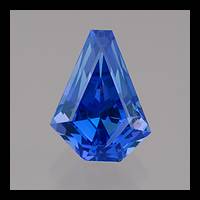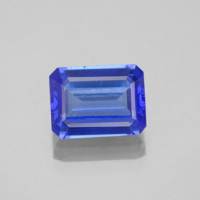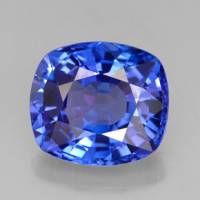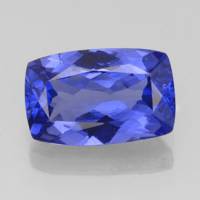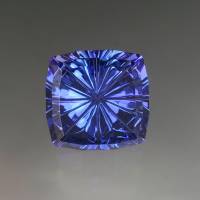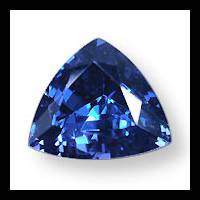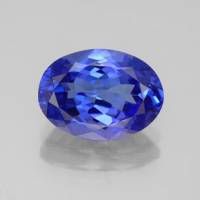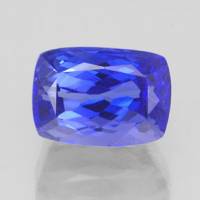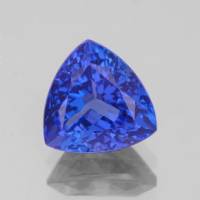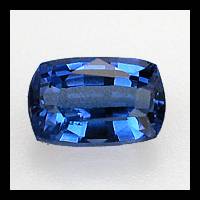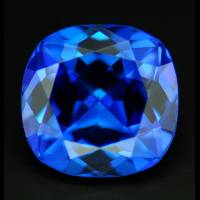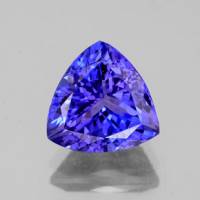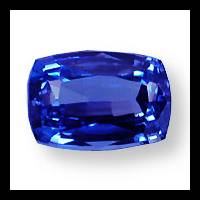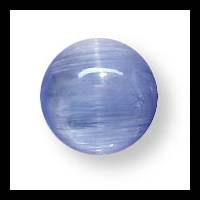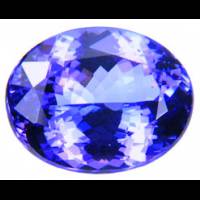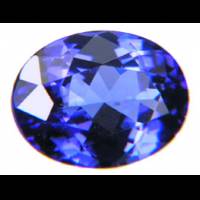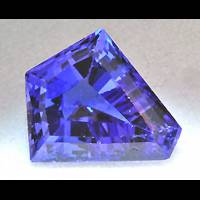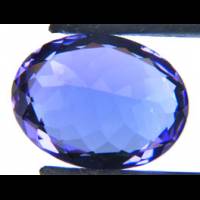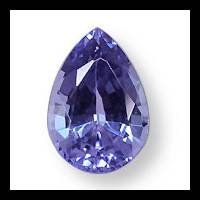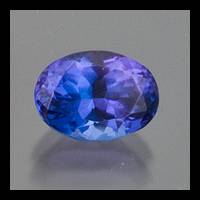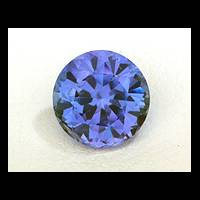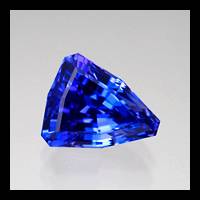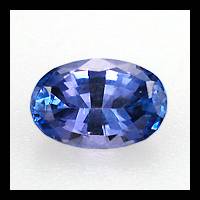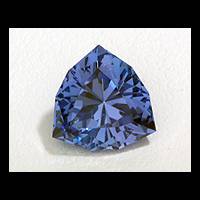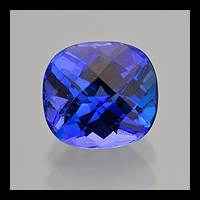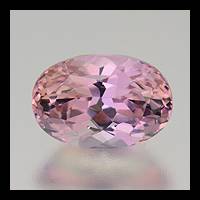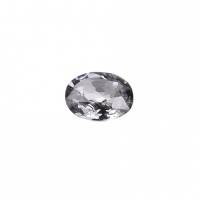Tanzanite
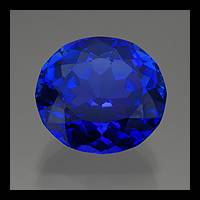
Tanzania
9.90 carats
© Palagems
Tanzanite is the blue-purple variety of Zoisite, it is noted for its remarkably strong trichroism, appearing sapphire blue, violet and burgundy depending on the position of crystal. Tanzanite also appears differently when viewed under alternate lighting conditions. In good quality the colour is ultramarine to sapphire blue; in artificial light, it appears more amethyst violet.
Tanzanite is universally heat treated to produce a range of hues between bluish-violet to violetish-blue, it has no effect on price.
Tanzanite Gemstones by Colour
This table shows the variety of hues this gemstone can be found in. Click on a photo for more information.
Tanzanite Gemstones by Size
This table shows distribution of Tanzanite gemstone sizes that are listed on this site. This can give a good indication as to the general availability of this gemstone in different sizes.
Contributed photos
Lightest:0.20 cts
Heaviest:15 cts
Average:3.04 cts
Total photos:69
Do you have a larger Tanzanite? Why not upload a photo?
| General Information | ||||||||||||||||||
|---|---|---|---|---|---|---|---|---|---|---|---|---|---|---|---|---|---|---|
| A variety or type of: | Zoisite | |||||||||||||||||
| Chemical Formula |
| |||||||||||||||||
| Tanzanite Treatments | ||||||||||||||||||
| When heated to 752 - 932 degrees F (400 - 500 degrees C), the interfering yellowish and brown tints vanish, and the blue becomes deeper. - Gemstones of the world, Walter Schumann, 2001, p 160 Heat-treatment of tanzanite gives violetish-blue colour, which is permanent and stable under normal conditions. There are no comparable untreated materials. - GIA | ||||||||||||||||||
| Tanzanite Simulants | ||||||||||||||||||
| There are glass imitations and doublets made from glass with tanzanite crown or made from two colourless synthetic spinels glued with tanzanite-coloured glue. - Gemstones of the world, Walter Schumann, 2001, p 160 Synthetic Forsterite, coranite - synthetic blue corundum, tanavyte - purple YAG, glass. - GIA 2019 | ||||||||||||||||||
| Physical Properties of Tanzanite | ||||||||||||||||||
| Mohs Hardness | 6.5 to 7, Gemstones of the world (2001) More from other references | |||||||||||||||||
| Specific Gravity | 3.35, Gemstones of the world (2001) More from other references | |||||||||||||||||
| Tenacity | Brittle, Gems, Sixth Edition (2006) | |||||||||||||||||
| Cleavage Quality | Perfect, Gemstones of the world (2001) | |||||||||||||||||
| Fracture | Uneven, Gemstones of the world (2001) | |||||||||||||||||
| Optical Properties of Tanzanite | ||||||||||||||||||
| Refractive Index | 1.685 to 1.707, Blue Chart Gem Identification (2010) More from other references | |||||||||||||||||
| Optical Character | Biaxial/+, Blue Chart Gem Identification (2010) More from other references | |||||||||||||||||
| Birefringence | 0.006 to 0.013, Blue Chart Gem Identification (2010) More from other references | |||||||||||||||||
| Pleochroism | Violet/purple stones - strong trichroism: strong blue - purple - greenish (to brownish) yellow; Blue stones - strong: strong blue - purple - greenish-yellow, Blue Chart Gem Identification (2010) More from other references | |||||||||||||||||
| Dispersion | 0.030, Gemstones of the world (2001) | |||||||||||||||||
| Chatoyancy | Yes, Gemmological Tables (2004) | |||||||||||||||||
| Colour | ||||||||||||||||||
| Colour (General) | Sapphire blue, amethyst, violet, Gemstones of the world (2001) More from other references | |||||||||||||||||
| Causes of Colour | Blue, (heat treated), V4+ in octahedral coordination; with V3+ in octahedral coordination. Brown-violet, V3+ in octahedral coordination (treatment turns blue). Green, Cr3+ in octahedral coordination., Pragmatic Spectroscopy For Gemologists (2011) | |||||||||||||||||
| Transparency | Transparent, Gemmological Tables (2004) More from other references | |||||||||||||||||
| Fluorescence & other light emissions | ||||||||||||||||||
| Fluorescence (General) | Inert, Blue Chart Gem Identification (2010) | |||||||||||||||||
| Fluorescence (Long-Wave UV) | Rare bluish, Blue Chart Gem Identification (2010) | |||||||||||||||||
| Crystallography of Tanzanite | ||||||||||||||||||
| Crystal System | Orthorhombic, Blue Chart Gem Identification (2010) | |||||||||||||||||
| Habit | Multifaced prisms, mostly striated, Gemstones of the world (2001) | |||||||||||||||||
| Geological Environment | ||||||||||||||||||
| Where found: | Tanzanite occurs in calcareous rocks, including metamorphosed dolomite and calcareous shales subjected to regional metamorphism., Gems, Sixth Edition (2006) | |||||||||||||||||
| Further Information | ||||||||||||||||||
| Mineral information: | Tanzanite information at mindat.org | |||||||||||||||||
| Significant Gem Localities | ||||||||||||||||||
| ||||||||||||||||||

